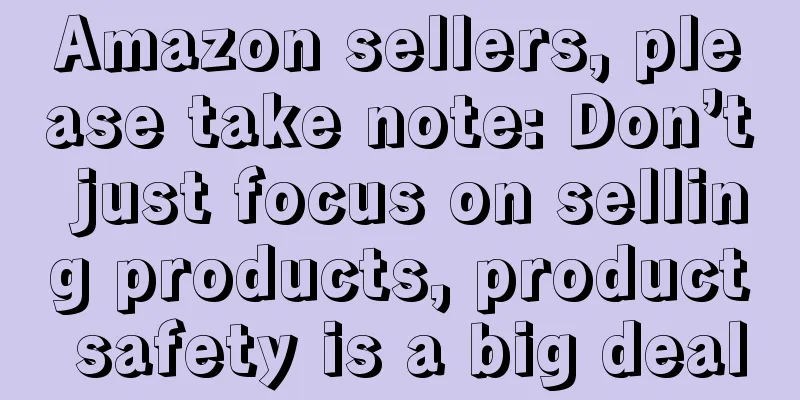|
Amazon's product safety issues have always been the focus of public attention. Recently, the Wall Street Journal stated that more than 4,000 unsafe or banned products were found on the Amazon platform.
Sellers evading Amazon platform policies is nothing new. CNBC also reported that Amazon approved sellers’ product listings before requiring or accepting product safety documents. Therefore, Amazon requires sellers to provide safety documents within a short period of time after the listing is online, otherwise there is a risk of account suspension.
To avoid losing sales privileges, sellers must comply with Amazon’s product safety and compliance policies, ensure that products meet safety requirements when listed, and always have safety documents ready to respond to Amazon’s requirements.
Amazon Security and Compliance Issues
Amazon's purpose is to be customer-centric, and it implements strict product safety and compliance policies to protect not only consumers but also platform sellers. In 2018, Amazon invested $400 million to protect the platform and consumers, and has developed some measures to ensure that the platform provides safe and compliant products without counterfeit products. These measures include Amazon adopting multiple verification methods when sellers apply for accounts, and using machine learning technology to prevent bad sellers from registering or listing products on the platform. In 2018, Amazon blocked 3 billion suspicious products from being listed on the platform by using automatic tools and expert teams to review security documents submitted by sellers.
In addition, Amazon uses technology to continuously scan product listings to detect whether there are security issues with active listings. Using machine learning, Amazon's tools can review millions of products, reviews, and 5 billion product updates every day to prevent suspicious products.
Amazon’s restrictions on listings
Regardless of whether Amazon approves the product listing before verifying the product’s safety documents, or reviews the documents after approving the listing, sellers have the obligation and responsibility to comply with Amazon’s product safety requirements.
All products on Amazon must comply with legal regulations and safety standards set by the Consumer Product Safety Commission . When listing and describing products, be sure to refer to these regulations, otherwise violating Amazon policies may result in: Restricted posting rights ·Prohibition of publication
All information on product listings must be accurate and proof is required, especially for health, safety or performance claims, to prove that the product: Can reduce the risk of concussion Environmentally friendly and green products
For pesticides or products with antibacterial, antifungal or other insecticidal effects, sellers must ensure that the products comply with the U.S. Federal Insecticide Fungicide Rodenticide Act (FIFRA) and related laws in each state that regulate labeling and ingredients.
Check out Amazon’s listing restrictions page for full details: http://uee.me/c5rqb Please note that some product categories require Amazon’s approval in advance before listing, and some require additional information and materials.
Although Amazon has imposed restrictions on product listings, some products that are considered dangerous goods or contain dangerous substances can still be listed and sold on the Amazon platform.
Dangerous goods may sound like toxic or deadly products, but Amazon uses this term to refer to consumer products used in daily life, such as laptops, mobile phones or detergents. These items are called dangerous goods because they contain flammable, corrosive and other substances that may pose a threat to the health and safety of consumers during storage, handling or transportation.
Dangerous goods shipped to Amazon warehouses must comply with the following regulations: Title 49 of the Code of Federal Regulations (49 CFR) ·International Air Transport Association Dangerous Goods Regulations (IATA DGR) Technical specifications for safe air transport of dangerous goods International Maritime Dangerous Goods (IMDG) Globally Harmonized System of Classification and Labelling of Chemicals (GHS)
Currently, FBA allows the sale of products containing magnetized materials (such as speakers or large magnets) and products containing lithium batteries (such as mobile power banks, cameras, mobile phones and battery chargers).
There are many types of lithium batteries, and sellers should pay attention to three main types of lithium batteries: lithium-ion batteries, lithium metal batteries and lithium-ion polymer batteries .
Amazon does not ship some lithium-ion battery products due to the extremely high amount of energy they store. Whether a lithium-ion battery can be shipped by Amazon depends on its energy content (measured in Watt-hours (Wh)), which varies by country.
Amazon also has a dangerous goods audit program (Hazmat), which stipulates which dangerous goods Amazon sellers can sell. Sellers who want to apply to join this program can log in to the website: http://uee.me/c5rr3 and click on the "look up an ASIN" tool.
Before listing products on Amazon, sellers need to understand the required security documents and organize them completely so that they can be provided immediately when Amazon requires them. If sellers are not prepared in advance, they may be blocked later.
When you create an FBA listing, you will need to answer questions about dangerous goods and batteries. Please be sure to provide complete information to ensure that your product is correctly classified and not banned from sale.
If your battery product uses lithium batteries, it will be classified as dangerous goods and you will need to provide the following information, including : Lithium battery packaging Watt-hours (Wh) per battery Lithium content per battery
If your product is considered a hazardous material, you need to provide Amazon with a Safety Data Sheet (SDS) . The Safety Data Sheet is provided by the product manufacturer or importer and describes the physical and chemical properties of the product, precautions for safe handling and use, emergency control measures, etc.
Amazon uses these data sheets to determine whether your product is regulated as a hazardous material, classify the product, and understand how to properly handle the product. The safety data sheets submitted by sellers must meet the following requirements : Created or updated within the past five years Contains the latest GHS / CLP hazardous materials identification Match the product information of the listing
You can also provide an exemption form to prove that the product does not need to provide a safety data sheet, but this only applies to battery products and products that do not contain hazardous substances.
Statement: When reprinting this article, the title and original text must not be modified, and the source and original link must be retained. | 









